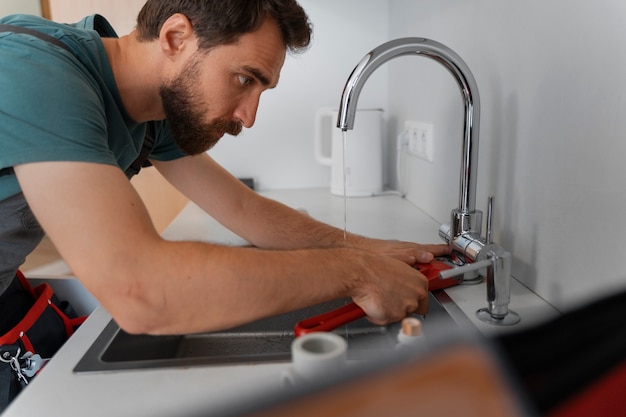We have uncovered this great article about Solved! How to Fix a Slow Sink Drain down the page on the web and think it made good sense to relate it with you on this page.

Introduction
We've all existed: You're cleaning your teeth or washing your hands, and you discover the water pooling in the sink. As opposed to rapidly swirling away, it lingers, turning your once-refreshing morning routine into a mini overload scene. A slow-draining sink isn't simply frustrating; it's frequently an indicator of larger plumbing issues hiding beneath the surface area. The good news is that most slow-draining sinks can be fixed with a little expertise, a few standard devices, and some patience. Ready to tackle this task head-on? Allow's roll up our sleeves and dive right in.
Comprehending the Root Causes Of a Slow-Draining Sink
Before you begin poking around in your pipelines, it assists to understand what may be triggering the downturn. Recognizing the origin makes it much easier to select the ideal fix.
Common Culprits Behind Slow Drain
So, what's clogging things up? Generally, it's a combination of everyday debris-- assume hair, soap scum, toothpaste residue, and remaining food particles. With time, these little bits accumulate and hold on to the pipeline wall surfaces, gradually tightening the flow and making it harder for water to go through. Sometimes, mineral deposits from hard water can additionally add to the crud, producing the perfect storm for persistent blockages.
When is it Time to Act?
If you observe the water draining pipes slower than common, it's an excellent idea to intervene faster instead of later on. Waiting also long can lead to complete blockages, unpleasant smells, or even pipe damages. If the water takes greater than a few secs to remove after shutting off the tap, consider it a red flag and prepare to put on your DIY hat.
Tools and Products You'll Need
The right devices make all the distinction. The good news is, you will not need a fully equipped plumbing professional's van to do the job.
Essential Devices for Do It Yourself Services
A bettor is your best starting point. A little, sink-sized bettor develops suction that can dislodge minor blockages. For more consistent blockages, a drain snake (sometimes called a plumbing professional's auger) functions marvels. A set of gloves, a flashlight, and possibly a set of safety safety glasses are also helpful.
Suggested Cleaning Solutions
Mild dish soap and warm water can assist break down greasy build-up. A mixture of cooking soda and vinegar is a time-tested home remedy, and chemical cleaners offer an even more environmentally friendly method. Maintain chemical drain cleansers as a last hope, as they can be harsh on your pipelines.
Safety First: Preventative Measures and Preparations
Prior to you launch into unclogging mode, think of safety and security. You're taking care of potentially filthy water and particles, so slip on a set of handwear covers. If you're using chemical cleaners, make certain the area is well-ventilated and comply with the guidelines on the label.
Protective Gear and Work Area Configuration
Lay down some old towels or dustcloths around the sink area to catch dashes. Eliminate any kind of things that might enter your means, like soap dispensers or toothbrush holders. Make certain you have great lighting-- order a flashlight if needed.
Step-by-Step Overview to Dealing With a Slow-Draining Sink
Now, allow's enter the nitty-gritty. This step-by-step procedure will certainly direct you via easy strategies to restore your sink's drain.
Action 1: Eliminate and Tidy the Stopper
Typically, the stopper (that tiny plug you push down to block water) is the very first offender. Remove it meticulously and clean off any hair or substance caught around its base. Wash it thoroughly before putting it back in place.
Step 2: Utilize a Plunger to Remove Particles
Got that plunger ready? Setting it over the drain and provide it a couple of company pumps. The concept is to create suction that can loosen any type of blockage. If you see littles debris drifting up, you get on the ideal track.
Action 3: Attempt a Drain Serpent or Wire Hanger
If the bettor doesn't work, it's time to draw out the drain serpent. Carefully feed it into the drain and spin as you go. You may feel some resistance-- that's most likely the blockage. Keep turning and pulling till you remove the blockage. If you don't have a drain serpent, a straightened cable hanger can operate in a pinch.
Tip 4: Apply a DIY Drainpipe Cleanser
An all-natural cleaner made from cooking soft drink and vinegar can break down recurring crud. Pour half a mug of cooking soda into the drainpipe, followed by half a cup of vinegar. Allow it fizz for about 15 mins, after that flush with hot water. This chemical reaction frequently does marvels for small obstructions.
Tip 5: Reconstruct and Test the Sink
Put everything back together and run the faucet. Does the water now swirl away at a commendable rate? If yes, offer on your own a pat on the back. Otherwise, do not anguish-- there are still a few more tricks up your sleeve.
Different Methods for Stubborn Clogs
Not all obstructions are produced equivalent. If your sink still rejects to cooperate, consider these alternate remedies.
Baking Soda and Vinegar Technique
We currently touched on this, but it deserves keeping in mind again. This mild, green method is more secure than chemical cleaners and often fairly effective.
Chemical Drainpipe Cleansers
Enzyme-based cleaners utilize natural germs to digest raw material. They're an outstanding selection if you're looking to prevent extreme chemicals. Just keep in mind, they might take a bit longer to function their magic.
Chemical Drainpipe Cleaners: Advantages And Disadvantages
Chemical cleaners can blast through hard blockages quickly, but they're not without drawbacks. They can create warm and fumes, damages pipelines if used exceedingly, and posture environmental dangers. Use them moderately, and always comply with the directions very carefully.
Safety Nets to Keep Your Sink Flowing
Prevention is the best treatment. By taking on a couple of basic routines, you can keep your sink from reducing to begin with.
Regular Cleansing Practices
Wipe down the sink container and component area frequently. Remove hair or food bits before they have a possibility to wash down the drainpipe.
Staying Clear Of Dangerous Substances Away
Hesitate prior to unloading coffee grounds, grease, or coarse veggie scraps down the sink. These culprits hold on to pipe wall surfaces, producing blockages gradually.
Routine Maintenance Checks
Set up a quick month-to-month examination. Run hot water with the sink for a few mins, paying attention to the flow. If it appears slow, act quickly before it becomes a full-blown clog.
When to Call a Professional Plumbing Technician
Occasionally, regardless of just how hard you try, that block just won't move. That's when it's time to generate the pros.
Indications That Indicate a More Significant Problem
If your sink drains pipes gradually despite multiple efforts, or if you discover water supporting in other fixtures (like your shower or toilet), you might have a more severe pipes issue hiding much deeper in the system.
Balancing DIY Initiatives with Expert Help
While DIY can save you cash and supply a sense of achievement, there's no embarassment in calling an expert. An expert plumber can evaluate your entire pipes setup, making certain there's no underlying damages or long-term problem that might cost you much more in the future.
Contrasting Costs and Long-Term Solutions
Before choosing, take into consideration the big picture. A low-cost, quick fix may fix the trouble momentarily, yet buying a much more long-term solution could save you cash and stress in the long run.
Evaluating the Expenses of DIY vs. Specialist Fixes
DIY fixes frequently set you back bit more than the rate of a plunger or a container of cooking soda. Specialist services, on the other hand, included a cost however might prevent repetitive issues and expensive fixings later.
Purchasing High Quality Fixtures and Upgrades
If your sink's design adds to regular blockages, it could be worth upgrading to higher-quality fixtures or modifying the plumbing design. Consider this an investment in your home's capability and convenience.
Conclusion
A slow-draining sink can feel like a small irritation, however it's often a sign that your plumbing needs a little TLC. By understanding the root causes, utilizing the right tools and strategies, and committing to simple preventive measures, you can maintain your sink streaming freely. And when all else fails, never hesitate to hire a professional-- your home's plumbing deserves the financial investment in care and upkeep.
How to Fix a Slow Sink Drain: 7 Methods
Clean the Stopper
Remove and clean the stopper. A pop-up drain stopper and the sloped shape of the sink are designed for optimal debris and build-up collection. If you do not have a drain zip tool, or the tool cannot clear out all debris, another option is to remove and clean the pop-up.
Most pop-ups are held in place with a nut attached to the drain just under the sink. To remove the pop-up, reach behind the drain pipe under the sink to find the pop-up nut. Once the nut is removed, the pop-up can be removed from the sink drain, cleaned, and reinstalled.
Use Homemade Drain Cleaner
Employ a DIY solution. A homemade drain cleaner can clean the drain pipes after the larger debris has been pulled out. The chemical reaction caused by combining two common and inexpensive household products, like vinegar and baking soda, can help break down the mucky build-up on the inside of the drain pipes and get the drain flowing freely again.
Pour 1/2 cup of baking soda down a slow-draining sink. Follow it with 1/2 cup of vinegar. Let the mixture rest for a few minutes. Rinse the solution with boiling water to clear the clog. Clear the Sink Overflow
Clean the overflow. The sink overflow is another place where debris and build-up can be collected over time. If a sink drains slowly and cleaning the drain doesn't work, try to clean the overflow.
The overflow opening is intended to divert water into the drain if it accidentally rises too high in the sink. It also allows air into the drain when the sink is filled with water, helping it drain faster.
Use a Plunger
Give it a good plunging. A plunger can be used on a slow sink drain; it does not have to be reserved for a complete drain stoppage. Plunging can help loosen and dislodge hair and debris in the pipe. To ensure the plunging motion is effective, cover the sink overflow with a rag or some duct tape to make a seal before plunging.
Use a Snake
Try a snake. If straightforward methods aren't working, consider getting a drain auger or snake to clear a bathroom or kitchen sink drain. A drain snake is a thin, flexible metal cable that can be wound or unwound on a reel. It has a drill or corkscrew-like end that can penetrate clogs, dislodge them, and pull them out.
Clean the P-Trap
Unclog the P-trap. If all other methods fail to clear a stubborn clog, the last step before calling a professional is removing and cleaning the P-trap or the drain pipe under the sink with a bend shaped like a "P" rotated 90 degrees, clockwise to the right. That U-shaped bend in the pipe is a top spot for gunk, like hair, food, grease, and debris, to build up and get clogged.
Once you remove the drain pipe, you need a bucket to catch residue, water, and debris. You might need Channellock pliers or a wrench if you can't unscrew the slip nuts by hand.
Tips to Prevent Slow-Draining Sinks
Sinks are only for water, soap, or toothpaste: Use toothpaste correctly and fully lather it in the mouth; do not let globs of toothpaste go undissolved down the drain. Stop hair and debris from going down the drain: Refrain from brushing your hair over the sink, or get a fine mesh drain hair catch for the drain hole. If shaving your face over the sink, wipe away the stubble with a washcloth, and rinse the washcloth and razor in a wash basin. Empty the water into the toilet or tub drain. Clean the sink stopper regularly: Remove the stopper and clean out any hair and dirt that may have lodged in the drain. Flush the sink with hot water regularly: Hot water will help move or loosen hardened or sludgy toothpaste, grease, mineral deposits, and hair. Some experts suggest using boiling water; however, beware since boiling water might melt PVC or crack porcelain.

We are very drawn to Solved! How to Fix a Slow Sink Drain and I'm hoping you enjoyed reading the entire blog entry. Please pause to share this blog post if you enjoyed it. Thanks so much for going through it.
Click Here
 Amanda Bynes Then & Now!
Amanda Bynes Then & Now! Jennifer Love Hewitt Then & Now!
Jennifer Love Hewitt Then & Now! Mike Vitar Then & Now!
Mike Vitar Then & Now! Kane Then & Now!
Kane Then & Now! Jane Carrey Then & Now!
Jane Carrey Then & Now!